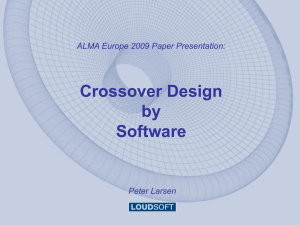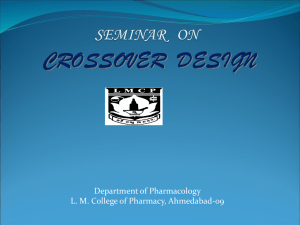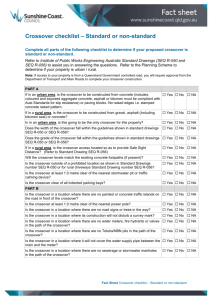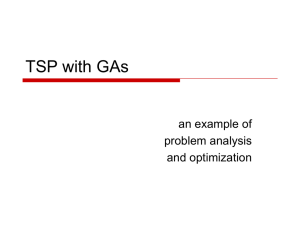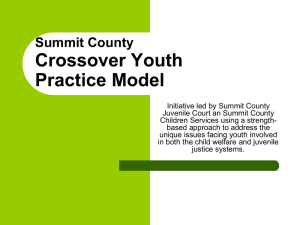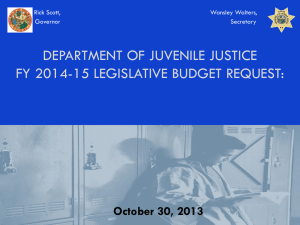Douglas-County-Crossover-Youth-Practice
advertisement
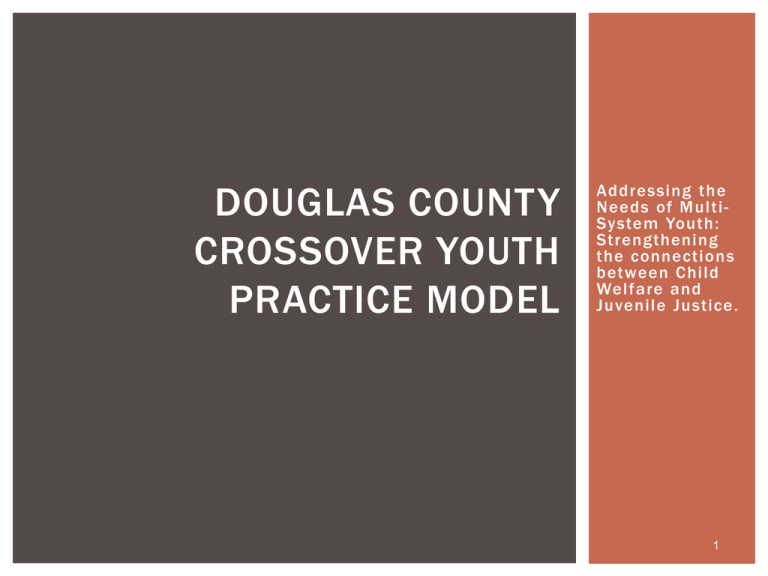
DOUGLAS COUNTY CROSSOVER YOUTH PRACTICE MODEL Addressing the Needs of Multi System Youth: Strengthening the connections between Child Welfare and Juvenile Justice . 1 HISTORY OF CROSSOVER YOUTH PRACTICE MODEL IN COLORADO National project supported by The Casey Family Programs and the Center for Juvenile Justice Reform at Georgetown University’s Public Policy Institute have been partnering since 2007 to address the unique issues presented by Crossover Youth. Denver County was the initial site in Colorado. Douglas County is part of the first cohort along with Broomfield, Larimer, and Morgan Counties, which began in August 2011. The second cohort includes El Paso, Jefferson, Rio Grande, Alamosa, and Conejos counties. 2 TARGET POPULATION A Crossover Youth is defined as a youth who has current or simultaneous involvement in both the child welfare and juvenile justice systems in the following ways; Youth initially involved in the child welfare system who are subsequently referred to and become involved in the juvenile justice system, and Youth who are initially involved in the juvenile justice system who are subsequently referred to and become involved in the child welfare system. 3 WHAT DO WE KNOW ABOUT CROSSOVER YOUTH? They are often in the child welfare system for long periods of time. Most are placed out of the home and often experience multiple placements. They are often truant and/or performing poorly in school. Over half are detained prior to adjudication. Research on Crossover youth increasingly points to the necessity of multi-system collaboration to comprehensively address the risks and needs of Crossover Youth. 4 GOALS OF THE PRACTICE MODEL Reduce the number of youth placed in out -of-home care, Reduce the use of congregate care, Reduce the disproportionate representation of children of color, and Reduce the number of youth being dually adjudicated. 5 ADDITIONAL GOALS Increased communication amongst agencies. Increased cooperation, coordination and integration of services provided by Douglas County Department of Human Services, Juvenile Justice and any other youth serving agencies. Increased youth and family engagement. Increased collaboration in joint assessment, case planning and case supervision. 6 SUPPORTING DATA Douglas County Data ; Child Welfare and Juvenile Justice currently have 80 shared cases, Of those 80 cases, 23 of them have both Dependency & Neglect and Delinquency cases, Of those 23 cases, 19 of them had a Delinquency case first. Douglas County Human Services currently has 40 children/youth placed out of their homes in congregate care. 29 of those children/youth have a delinquency case. 7 ACTION STEPS TO ACHIEVE GOALS • Consistent Court Oversight: One magistrate handling both Delinquency and Dependency and Neglect cases. Avoiding inconsistent orders and multiple hearings • Increased Collaboration: Coordinated case planning with families and agencies. Family engagement through joint case planning. • Improved Service Delivery: Expedited service delivery Identifying the right service at the right time. 8 CROSSOVER YOUTH PRACTICE MODEL PILOT Phase 1 Arrest, Identification, and Detention A youth is identified through contact with: the Juvenile Assessment Center, or the District Attorney’s Office, if youth has been issued a summons, or assigned Probation Officer and/or Pre-Trial Case Manager requests Child Welfare involvement. Detention Hearing The Pre-Trial Case Manager and/or assigned Caseworker will be present at the detention hearing to address the court as needed. 9 CROSSOVER YOUTH PRACTICE MODEL PILOT Pre-Trial Release will be ordered on all Crossover Youth, unless a Crossover Youth is placed out of home or is already on Probation. Pre-Trial will begin working with the youth and family immediately, even if youth remains in detention. Pre-Trial Release Case Manger will distribute the Crossover Youth Practice Model brochure to the youth and family, which includes information about the Crossover Youth process. A multi-system release will be signed at court hearing. 10 CROSSOVER YOUTH PRACTICE MODEL PILOT Phase 2 Case Assignment, Joint Assessment, and Planning Within 3-5 business days of a youth being identified as a Crossover Youth, a coordinated joint meeting, including the youth, family, Pre-Trial Case Manager or Probation Officer, and Department of Human Services Case Worker, will be scheduled with the family at their home or at the detention center, to begin family engagement and case planning. Guardians ad Litem or other individuals may be included, at the family’s request. 11 CROSSOVER YOUTH PRACTICE MODEL PILOT The assigned workers (Department of Human Services Case Worker and Pre-Trial Case Manager or Probation Officer) will complete a joint assessment of the youth and family, Review of behavior patterns over time; Examination of the family strengths and protective factors; Assessment of the overall needs of youth and family that affect safety, permanency, and well-being; Consideration of contributing factors in the home, such as domestic violence, substance abuse, mental health, chronic health problems, and poverty; The Colorado Juvenile Risk Assessment (CJRA) will be completed to identify criminogenic factors including peer group, school performance, family dynamics, substance abuse, self -regulation, history of delinquent behaviors; Review of information gathered through other assessments from partnering agencies. 12 CROSSOVER YOUTH PRACTICE MODEL PILOT Family and Child Engagement Support (FACES) A multi-disciplinary team meeting is requested by Case Lead within 5-10 business days after the completed home visit or at the detention center. A FACES meeting will be held every Wednesday afternoon. The meetings will be held at Douglas County Department of Human Services or the detention center. FACES referrals need to submitted by noon on Friday. An agenda will be sent out by 3pm on the Friday prior to the FACES meeting. 13 CROSSOVER YOUTH PRACTICE MODEL PILOT • Joint Case Planning Identify need areas and goals, tasks, interventions and services. Focus interventions on assisting parents/caregivers to improve their parenting skills and provide youth with opportunities to change their high risk behaviors. Action steps should be focused, time limited, behaviorally specific, obtainable, understandable, relevant, and agreed to by youth and family. 14 CROSSOVER YOUTH PRACTICE MODEL PILOT Phase 3 Coordinated Case Supervision & Ongoing Assessment A transition meeting will occur with the Pre-Trial Case Manager and the Probation Officer within 3-5 business days after sentencing to exchange information. Ongoing monthly contact will occur between all professionals involved to monitor progress of the case plan. Meetings will occur with the youth, family, Case Worker, Pre -Trial Case Manager/Probation Officer, Guardians Ad Litem; including: Prior to court hearings Significant changes in family dynamics Per request of a family member and/or any professional Assigned Caseworker will complete a written review from date of completed case plan every 90 days and distributed as needed. 15 CROSSOVER YOUTH PRACTICE MODEL PILOT Phase 3 Planning for Permanency and Case Closure Begin planning for permanency at the onset of a case; Ensure continued joint case planning between all systems involved throughout the life of the case; Embed learning opportunities for independent living skills and Permanency Roundtables for age appropriate youth throughout service delivery of the case. 16 QUESTIONS? 17 THIS PROJECT HAS BEEN SUPPORTED BY; Chief Judge William Sylvester & Magistrate Beth Elliott Dumler 18 th Judicial District Probation Department Douglas County Department of Human Services Juvenile Assessment Center Senate Bill-94 House Bill 1451 Collaborative Management Program Douglas County Guardians Ad Litem Douglas County School District Arapahoe Douglas Mental Health Network Douglas County Sheriff’s Of fice 18 th Judicial District Attorney’s Of fice 18 WORKS CITED http://cjjr.georgetown.edu/resources.html Herz & Ryan, 2008b;Halemba, Siegel, Lord & Zawacki 2004; Kelley, Thornberry, & Smith, 1997, Saeturn & Swain 2009. Wiig & Tuell, 2004, Siegel, Lord, 2004; Halemba, 2005; American Bar Association 2008; Herz & Ryan, 2008; Bilchik & Nash, 2009. 19

